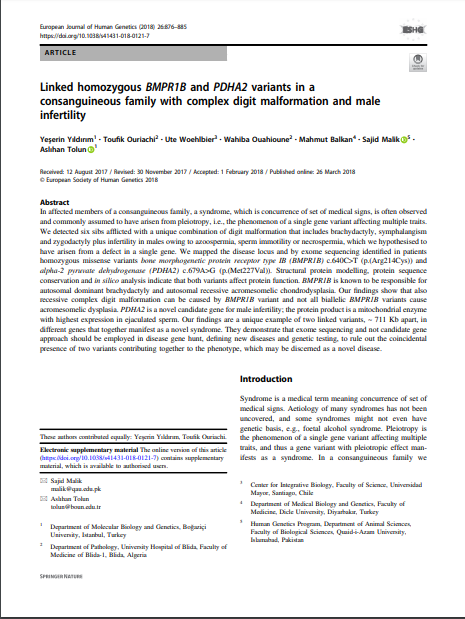Linked homozygous BMPR1B and PDHA2 variants in a consanguineous family with complex digit malformation and male infertility

Fecha
2018Autor
Woehlbier, Ute [Univ Mayor, Ctr Integrat Biol, Fac Sci, Santiago, Chile]
Yildirim, Yeserin
Ouriachi, Toufik
Ouahioune, Wahiba
Balkan, Mahmut
Malik, Sajid
Tolun, Aslihan
Ubicación geográfica
Notas
HERRAMIENTAS
Acceda a títulos restringidos
¿Cómo descargar?Resumen
In affected members of a consanguineous family, a syndrome, which is concurrence of set of medical signs, is often observed and commonly assumed to have arisen from pleiotropy, i.e., the phenomenon of a single gene variant affecting multiple traits. We detected six sibs afflicted with a unique combination of digit malformation that includes brachydactyly, symphalangism and zygodactyly plus infertility in males owing to azoospermia, sperm immotility or necrospermia, which we hypothesised to have arisen from a defect in a single gene. We mapped the disease locus and by exome sequencing identified in patients homozygous missense variants bone morphogenetic protein receptor type IB (BMPR1B) c.640C>T (p.(Arg214Cys)) and alpha-2 pyruvate dehydrogenase (PDHA2) c.679A>G (p.(Met227Val)). Structural protein modelling, protein sequence conservation and in silico analysis indicate that both variants affect protein function. BMPR1B is known to be responsible for autosomal dominant brachydactyly and autosomal recessive acromesomelic chondrodysplasia. Our findings show that also recessive complex digit malformation can be caused by BMPR1B variant and not all biallelic BMPR1B variants cause acromesomelic dysplasia. PDHA2 is a novel candidate gene for male infertility; the protein product is a mitochondrial enzyme with highest expression in ejaculated sperm. Our findings are a unique example of two linked variants, similar to 711 Kb apart, in different genes that together manifest as a novel syndrome. They demonstrate that exome sequencing and not candidate gene approach should be employed in disease gene hunt, defining new diseases and genetic testing, to rule out the coincidental presence of two variants contributing together to the phenotype, which may be discerned as a novel disease.
Coleccion/es a la/s que pertenece:
Si usted es autor(a) de este documento y NO desea que su publicación tenga acceso público en este repositorio, por favor complete el formulario aquí.